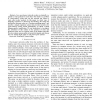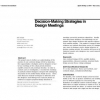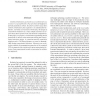5054 search results - page 30 / 1011 » How designers design and program interactive behaviors |
INFOCOM
2005
IEEE
15 years 5 months ago
2005
IEEE
Abstract— In a peer-to-peer network, nodes are typically required to route packets for each other. This leads to a problem of “free-loaders,” nodes that use the network but r...
UIST
1995
ACM
15 years 3 months ago
1995
ACM
This paper describes some design refinements on marking menus and shows how these refinements embody interesting and relevant design principles for HCI. These refinements are base...
95
Voted
CHI
2007
ACM
16 years 3 days ago
2007
ACM
This project aims to further our understanding of the practice of user-centered design (UCD) by observing the argumentation strategies used by designers in faceto-face meetings in...
PERSUASIVE
2009
Springer
15 years 6 months ago
2009
Springer
Persuasive Technology has the potential to influence user behavior for social benefit, e.g. to reduce environmental impact, but designers are lacking guidance choosing among desig...
ICTAI
2008
IEEE
15 years 6 months ago
2008
IEEE
Control architectures, such as the LAAS architecture [1], CLARATY [12] and HARPIC [9], have been developped to provide autonomy to robots. To achieve a robot’s task, these contr...



